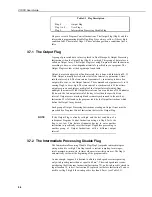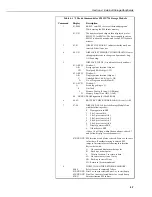
Section 4. External Storage Peripherals
4-5
4.3.1 Storage Module Addressing
The address of a CSM1 is always 1, and only one CSM1 can be
connected to the CR10X.
Assigning different addresses to the SM192/716 Storage Modules allows:
1.
Multiple (up to eight) Storage Modules to be connected to the CR10X during
on-line output (Instruction 96),
2.
Different data to be output to different Modules, and
3.
Transfer of data from a Module that is left with the CR10X to a Module that
is hand carried to the site for data transfer (*9 Mode).
Storage Modules are assigned addresses (in the range 1-8) using either the *9
Mode, telecommunications commands (see SM192/SM716 Manual) or by using
Campbell Scientific Datalogger Support Software (SMCOM or SMS). The default
address when the Storage Module is reset is 1, and unless you are using one of the
features which needs different addresses you need not assign any other address.
Address 1 is also a universal address when sending data or commands to a
Storage Module with Instruction 96, or with the *8 or *9 Modes. When address 1
is entered in the *9 Mode (default) or in the device code for Instruction 96 or the
*8 Mode, the CR10X searches for the Storage Module with the lowest address
that is not full (fill and stop configuration only) and addresses it. In other words, if
a single Storage Module is connected, and it is not full, address 1 will address that
Storage Module regardless of the address that is actually assigned to the Module.
Address 1 would be used with Instruction 96 if several Storage Modules with dif-
ferent addresses were connected to the CR10X and were to be filled sequentially.
The Storage Modules would be configured as fill and stop. When the lowest
addressed Module was full data would be written to the next lowest addressed
Module, and so on.
4.3.2 Storage Module use with Instruction 96
When output to the Storage Module is enabled with Instruction 96, the Storage
Module(s) may be either left with the CR10X for on-line data transfer and
periodically exchanged, or brought to the site for data transfer.
Use of Storage Module to Pick Up Data
The CR10X detects whether or not the Storage Module is connected. Each time
Instruction 96 is executed and there is data to output, the CR10X checks for the
presence of a Storage Module. If one is not present, the CR10X does not attempt
to output data to it. Instead, the CR10X saves the data and continues its other
operations without advancing the Storage Module Pointer (see Section 2 for
information on pointers).
When you connect the Storage Module to the CR10X, two things happen:
1.
Immediately on connection, a File Mark is placed in the Storage Module
memory following the last data stored (if a File Mark wasn’t the last data
point already stored).
2.
During the next execution of Instruction 96, the CR10X recognises that the
Storage Module (SM) is present and outputs all data between the SPTR and
the DSP location.
NOTE
















































